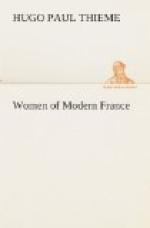Nearly every large establishment kept open house, dining from twenty to thirty persons every day. They dined at one, separated at three, were at the theatre at five, and returned with as many friends as possible—the more, the greater the reputation for hospitality and popularity. Under such circumstances, the mother had no time for the daughters, nor were the conversations at those dinners food for young, innocent girls—and innocence was the first requirement of a marriageable young woman.
The great convents were the Abbaye-aux-Bois and Penthemont, where the daughters of the wealthiest and highest families were educated. In those convents or seminaries, strange to say, the young girls were taught the most practical domestic duties, as well as dancing, music, painting, etc. Such teachers as Mole and Larrive gave instruction in declamation and reading, and Noverre and Dauberval in dancing; the teaching nuns were all from the best families. The most complete costumes, scenic decorations, and other equipments of a complete theatre were supplied, special hours being set aside for the play. However, much intriguing went on there, and many friendships and lifelong enmities were formed, which later led to serious troubles.
Often, from the midst of a group of young girls of from ten to fifteen years of age, one would be notified of her coming marriage with a man she had never seen, and whom, in all probability, she could not love, having given her heart to another. If it turned out to be an uncongenial marriage, a separate life would be the result, and, while still absolutely ignorant of the world, those young married women would fall prey to the charms of young gallants or men of quality, and a liaison would follow.
The difference between a liaison of the seventeenth century and one of the eighteenth led to one essential difference in the standards of social and moral etiquette; in the former period, a liaison meant nothing more censurable than an intimate friendship, a purely platonic love; the lover simply paid homage to the lady of his choice; it was an attraction of common intellectual interests and usually lasted for life; in the eighteenth century, a liaison was essentially immoral, rarely a union of interests, but rather one of passions and physical propensities. Such relations developed and fostered deceit, intrigues, infidelity, and rivalry, one woman endeavoring to allure the lover of another; affairs of that nature were the chief topic of conversation in social circles, and were soon reflected in every phase of the intelligent world. This will be seen in the study of the eighteenth century.
Chapter VIII
Salon Leaders Mme. de Tencin, Mme. Geoffrin, Mme. du Deffand, Mlle. de Lespinasse, Mme. du Chatelet




